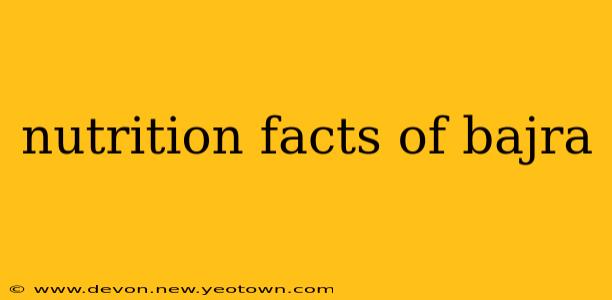Bajra, also known as pearl millet, is a humble grain with an impressive nutritional profile. For centuries, it's been a staple food in many parts of the world, particularly in arid and semi-arid regions, proving its resilience and nutritional value. But what exactly makes this grain so special? Let's embark on a journey to explore the fascinating world of bajra and uncover its hidden nutritional treasures.
My name is Anya Sharma, and as a registered dietitian with over 10 years of experience, I've dedicated my career to exploring the nutritional benefits of ancient grains and helping people understand the power of food. Today, we’ll be unraveling the nutritional secrets of bajra.
What are the key nutritional benefits of Bajra?
Bajra is a nutritional powerhouse, packed with essential nutrients that contribute to overall health and well-being. It's a rich source of complex carbohydrates, providing sustained energy without the blood sugar spikes associated with refined grains. But that’s just the beginning. It boasts a significant amount of dietary fiber, promoting healthy digestion and preventing constipation. Beyond this, bajra is an excellent source of:
- Protein: A crucial component for building and repairing tissues, bajra offers a decent amount of protein, making it a valuable addition to vegetarian and vegan diets.
- Minerals: It's a good source of essential minerals like iron, magnesium, and phosphorus, all vital for various bodily functions. Iron is crucial for oxygen transport, magnesium supports muscle and nerve function, and phosphorus is vital for bone health.
- Vitamins: Bajra contains several B vitamins, including niacin, thiamin, and riboflavin, which play essential roles in energy metabolism and nerve function.
What are the health benefits of eating Bajra?
The impressive nutritional composition of bajra translates into a wide array of health benefits. Regular consumption can contribute to:
- Improved Blood Sugar Control: The high fiber content and low glycemic index help regulate blood sugar levels, making it beneficial for individuals with diabetes or those at risk of developing it.
- Better Heart Health: The fiber and magnesium in bajra contribute to lowering cholesterol levels and blood pressure, reducing the risk of heart disease.
- Enhanced Digestive Health: The abundance of dietary fiber promotes healthy bowel movements, preventing constipation and improving overall gut health.
- Weight Management: The high fiber content keeps you feeling full for longer, helping to control appetite and manage weight.
- Stronger Bones: The presence of phosphorus and other minerals contributes to strong and healthy bones.
Is Bajra gluten-free?
Yes, bajra is naturally gluten-free, making it a suitable choice for individuals with celiac disease or gluten sensitivity. This characteristic adds another layer to its appeal as a healthy and inclusive grain option.
How many calories are in Bajra?
The calorie count in bajra varies slightly depending on preparation methods. However, a typical serving (around 100 grams) contains approximately 360 calories. This calorie content makes it a reasonably energy-dense food, providing sustained energy throughout the day.
What are some ways to incorporate Bajra into my diet?
The versatility of bajra is one of its greatest assets. You can incorporate it into your diet in numerous ways:
- Bajra Roti: The most common preparation, bajra roti is a flatbread made from bajra flour.
- Bajra Khichdi: A hearty and nutritious porridge made with bajra, lentils, and spices.
- Bajra Dosa: South Indian-style pancakes made with bajra flour.
- Bajra Porridge: A quick and easy breakfast option.
- Adding Bajra Flour to Bread or Cakes: Incorporate bajra flour into your baking for added nutrition and flavor.
With its remarkable nutritional profile and adaptability in the kitchen, bajra deserves a prominent place in a healthy and balanced diet. It's a testament to the nutritional wisdom of traditional food systems and a valuable addition to modern diets seeking nutritional diversity and overall health improvement.

